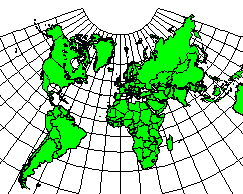

World Map
Lambert Conformal Conic Projection
Central Longitude: 0
Central Latitude: 0
Standard Parallel: 45
2nd Standard Parallel: 0
In a Lambert Conformal Conic projection, scale is constant along any given parallel and accurate along the specified standard parallels. Scale is the same in all directions at any given point. This projection is useful for equal area maps of low-aspect regions (regions that are wider than they are tall). The pole is a point in the hemisphere containing the standard parallels and the graticules stretch to infinity in the other hemisphere. The Lambert Conformal Conic projection is used for many of the zones in the State Plane Coordinate System.
|
Parameter |
Description |
|
Name |
Specifies the units used in the map. |
|
Scale |
Specifies the unit scale of the projected map, relative to meters. For example, a scale of one means one unit in the projected map equals one meter; a scale of two means two units in the projected map equal one meter; etc. |
|
False Easting |
Specifies the false easting, or horizontal offset, of the projected coordinates, in meters. False Eastings and False Northings are added to the underlying "projected" coordinates as a way to arbitrarily offset their internal XY coordinates after the projection. Unless you have a reason for using these offset values, do not use them. These values do not affect the latitude/longitude coordinates for the map, only the internal coordinates used to plot the map on the screen. If you use False Easting and False Northing offsets for a map, any subsequent boundaries you append to the map must also use these same offsets if you want the imported boundaries to be drawn in the correct relative position to the existing boundaries. |
|
False Northing |
Specifies the false northing, or vertical offset, of the projected coordinates, in meters. See above. |
|
Central Longitude |
Specifies the central longitude of the projection in degrees. The Central Longitude value typically should be defined as the longitudinal center of the map you are going to produce. For example, the value -95.5 represents the geographic center of the United States, so the map of the U.S. is drawn upright. |
|
Central Latitude |
Specifies the central latitude of the projection in degrees. The Cetnral Latitude value should be defined as the latitudinal center of the map you are going to produce. This value is only significant when you define False Easting and False Northing values. |
|
Standard Parallel |
Specifies the latitude of the first of two standard parallels, in degrees. The Standard Parallels typically are defined at approximately one-sixth of the distance inside the north and south limits of the map. For example, if your map latitude ranges from 30° to 36°, you could place your Standard Parallels at 31° and 35°. There are alternative methods for determining the best position of the standard parallels. Please see Snyder for more information. |
|
2nd Standard Parallel |
Specifies the latitude of the second of two standard parallels, in degrees. See above. |
See Also
Introduction to Map Projections
Characteristics of Projections
Latitude/Longitude Coordinates
Latitude/Longitude in Decimal Degrees
Using Scaling to Minimize Distortion in Latitude/Longitude Projects